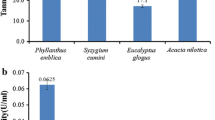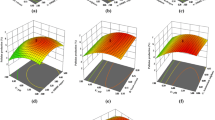Abstract
Tannase production by newly isolated Penicillium purpurogenum PAF6 was investigated by ‘one variable at a time’ (OVAT) approach followed by response surface methodology (RSM). Tannin-rich plant residues were used as supporting solid substrate and sole carbon source and, among them, tamarind seed was found to be the most favorable substrate than haritaki, pomegranate, tea leaf waste and arjun fruit. Physicochemical parameters were initially optimized using OVAT methodology and some important factors like incubation time, incubation temperature, substrate:moisture ratio as well as carbon, nitrogen and phosphate concentrations were verified with Box–Behken design of response surface methodology. Phosphate source, nitrogen source and temperature were found as the most favorable variables in the maximization of production. Tannase production was enhanced from 1.536 U/g to 5.784 U/g using tamarind seed OVAT optimization and further enhancement up to 6.15 U/g following RSM. An overall 3.76- and 4.0-fold increases in tannase production were achieved in OVAT and RSM, respectively.








Similar content being viewed by others
References
Das Mohapatra, P. K., Mondal, K. C., & Pati, B. R. (2007). Journal of Applied Microbiology, 102, 1462–1467.
Lekha, P. K., & Lonsane, B. K. (1997). Advances in Applied Microbiology, 44, 215–260.
Chandini, S. K., Jaganmohan, R. L., Gowthaman, M. K., Haware, D. J., & Subramanian, R. (2011). Food Chemistry, 127, 1039–1045.
Selwal, M. K., Yadav, A., Selwal, K. K., Aggarwal, N. K., Gupta, R., & Gautam, S. K. (2011). Brazilian Journal of Microbiology, 42, 374–387.
Aguilar, C. N., & Sanchez, G. (2001). Food Science and Technology International, 7, 373–382.
Lekha, P. K., & Lonsane, B. K. (1994). Process Biochemistry, 29, 497–503.
Archambault, J., Lacki, K., & Duvnjak, Z. (1996). Biotechnology Letters, 18, 771–774.
Muir, R. M., Ibanez, A. M., Uratsu, S. L., Ingham, E. S., Leslie, C. A., McGranahan, G. H., Batra, N., Goyal, S., Joseph, J., Jemmis, E. D., & Dandekar, A. M. (2011). Plant Molecular Biology. doi:10.1007/s11103-011-9739-3.
Das Mohapatra, P. K., Mondal, K. C., & Pati, B. R. (2006). Polish Journal of Microbiology, 55, 297–301.
Hadi, T. A., Banerjee, R., & Bhattacharya, B. C. (1994). Bioprocess Engineering, 11, 239–243.
Rodrigues, T. H. S., Pinto, G. A. S., & Gonçalves, L. R. B. (2008). Biotechnology and Bioprocess Engineering, 13, 571–576.
Lokeswari, N. (2010). Rasayan Journal of Chemistry, 3, 32–37.
Arulpandi, I., Sangeetha, R., & Kalaichelvan, P. T. (2010). Zaffius Biotechnology, 3, 1–7.
Srivastava, A., & Kar, R. (2009). Brazilian Journal of Microbiology, 40, 782–789.
Hota, S. K., Dutta, J. R., & Banerjee, R. (2007). Indian Journal of Biotechnology, 6, 200–204.
Saxena, S., & Saxena, R. K. (2004). Biotechnology and Applied Biochemistry, 39, 99–106.
Selwal, M. K., Yadav, A., Aggarwal, N. K., Kumar, K., & Kumar, A. (2008). World Journal of Microbiology and Biotechnology, 24, 3023–3030.
Mukherjee, G., & Banerjee, R. (2006). World Journal of Microbiology and Biotechnology, 22, 207–212.
Mahapatra, K., Nanda, R. K., Bag, S. S., Banerjee, R., Pandey, A., & Szakacs, G. (2005). Process Biochemistry, 40, 3251–3254.
Panda, B. P., Mazumdar, R., & Banerjee, R. (2009). Journal of Pharmacy and BioAllied Sciences, 1, 37–42.
Selwal, M. K., & Selwal, K. K. (2011). Annals of Microbiology. doi:10.1007/s13213-011-0238-1.
Lokeswari, N., & Reddy, D. S. R. (2010). Pharmacophore, 1, 112–122.
Sherief, A. A., EL-Tanash, A. B., & Nour, A. (2011). Biotechnology. doi:10.3923/biotech.2011.
Yee, T. W., Prabhu, N. G., Jain, K., & Ibrahim, D. (2011). African Journal of Biotechnology, 10, 13147–13154.
Ordonez, R. M., Colombo, I., Alberto, M. R., & Isla, M. I. (2011). World Journal of Microbiology and Biotechnology. doi:10.1007/s11274-011-0699-1.
Nutan, D., Ulka, S. P., Kulbhusan, B. B., Jayant, M. K., & Digamber, V. G. (2002). Process Biochemistry, 38, 715–721.
Box, G. E. P., Hunter, W. G., & Hunter, J. S. (1978). Statistics for experiments: An introduction to design, data analysis, and model building. New York: Wiley.
Haaland, P. D. (1989). Statistical problem solving in experimental design in biotechnology. New York: Marcel Dekker.
Schanderi, S. H. (1970). Methods in food analysis. New York: Academic Press.
Mondal, K. C., Banerjee, D., Jana, M., & Pati, B. R. (2001). Analytical Biochemistry, 295, 168–171.
Kar, B., Banerjee, R., & Bhattacharyya, B. C. (1999). Journal of Industrial Microbiology and Biotechnology, 23, 173–177.
Kumar, R. A., Gunasekaran, P., & Lakshmanan, M. (1999). Journal of Basic Microbiology, 39, 161–168.
Holker, U., Hofer, M., & Lenz, J. (2004). Applied Microbiology and Biotechnology, 64, 175–186.
Sabu, A., Pandey, A., Daud, M. J., & Szakacs, G. (2005). Bioresource Technology, 96, 1223–1228.
Raimbault, M., & Alazardd, D. (1980). European Journal of Applied Microbiology and Biotechnology, 9, 199–209.
Ahmed, W. B., Haq, I., & Iqbal, J. (2002). Biosynthesis of xylanase by UV-treated mutant strain of Aspergillus niger GCBMX-45. Biotechnology, 1, 10–14.
Rajasimman, M., & Subathra, S. (2010). International Journal of Chemistry and Biomolecular Engineering, 3, 1–7.
Sharma, S., Agarwal, L., & Saxena, R. K. (2007). Indian Journal of Microbiology, 47, 132–138.
Naidu, R. B., Saisubramanian, N., Sivasubramanian, S., Selvakumar, D., Janardhanan, S., & Puvanakrishnan, R. (2008). Current Trends in Biotechnology and Pharmacy, 2, 523–530.
Das Mohapatra, P. K., Maity, C., Rao, R. S., Pati, B. R., & Mondal, K. C. (2009). Food Research International, 42, 430–435.
Sivashanmugam, K., & Jayaraman, G. (2011). African Journal of Microbiology Research, 5, 3611–3615.
Batra, A., & Saxena, R. K. (2005). Process Biochemistry, 40, 1553–1557.
Acknowledgement
Financial support offered by the University Grant Commission, New Delhi, India is thankfully acknowledged.
Author information
Authors and Affiliations
Corresponding author
Rights and permissions
About this article
Cite this article
Jana, A., Maity, C., Halder, S.K. et al. Tannase Production by Penicillium purpurogenum PAF6 in Solid State Fermentation of Tannin-Rich Plant Residues Following OVAT and RSM. Appl Biochem Biotechnol 167, 1254–1269 (2012). https://doi.org/10.1007/s12010-012-9547-5
Received:
Accepted:
Published:
Issue Date:
DOI: https://doi.org/10.1007/s12010-012-9547-5




